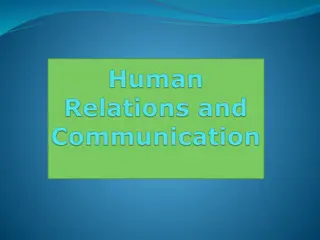Effective Nonverbal Communication in Health Care
Explore the significance and functions of nonverbal communication in the health care setting. Understand how nonverbal cues impact communication effectiveness and relationships. Discover the dimensions and examples of nonverbal communication.
Download Presentation

Please find below an Image/Link to download the presentation.
The content on the website is provided AS IS for your information and personal use only. It may not be sold, licensed, or shared on other websites without obtaining consent from the author.If you encounter any issues during the download, it is possible that the publisher has removed the file from their server.
You are allowed to download the files provided on this website for personal or commercial use, subject to the condition that they are used lawfully. All files are the property of their respective owners.
The content on the website is provided AS IS for your information and personal use only. It may not be sold, licensed, or shared on other websites without obtaining consent from the author.
E N D
Presentation Transcript
Professionalism/Customer Service in the Health Care Environment Key Elements of Effective Communication Nonverbal Communication Lecture b This material (Comp16 Unit4) was developed by The University of Alabama at Birmingham, funded by the Department of Health and Human Services, Office of the National Coordinator for Health Information Technology under Award Number 1U24OC000023. This material was updated in 2016 by Bellevue College under Award Number 90WT0002. This work is licensed under the Creative Commons Attribution-NonCommercial-ShareAlike 4.0 International License. To view a copy of this license, visit http://creativecommons.org/licenses/by-nc-sa/4.0/.
Nonverbal Communication Learning Objectives Define nonverbal communication. Describe how nonverbal communication functions in the human communication process. Describe specific dimensions and give examples of nonverbal communication. 2
Nonverbal Communication Definition: Nonverbal communication is communication that occurs without words including messages created through body language and the use of space, sound or touch. Northouse & Northouse, 1998 3
Nonverbal Communication Continued Vocal Scream, sigh, groan, whistle Nonvocal Smile, gaze, frown Intentional or unintentional 4
Importance of Nonverbal Communication Up to 93% of communication effectiveness determined by nonverbal cues To be most effective, verbal message and nonverbal message must match Northouse & Northouse, 2007 5
Functions of Nonverbal Communication Even in a face-to-face communication, one or more of the following functions may occur through nonverbal means: Reinforce expression of feelings or emotion Shift the conversation in a different direction or even end it Maintain self-image Confirm relationships 6
Functions of Nonverbal Communication Continued Reinforces expression of feelings and emotions Can reinforce or contradict verbal message 7
Functions of Nonverbal Communication Continued 2 Reinforces expression of feelings and emotions Can reinforce or contradict verbal message Can shift the conversation in a different direction or even end it 8
Functions of Nonverbal Communication Continued 3 Health IT professionals should Be conscious of their own nonverbal communication Display deference, not judgment, toward clinicians 9
Functions of Nonverbal Communication Continued 4 Reinforce expression of feelings or emotion Shift the conversation in a different direction or even end it Maintain one s self-image 10
Functions of Nonverbal Communication Continued 5 Reinforce expression of feelings or emotion Shift the conversation in a different direction or even end it Maintain one s self-image Confirm relationships 11
Dimensions of Nonverbal Communication Nonverbal communication is commonly divided into five distinct categories: 1. Kinesics 2. Proxemics 3. Paralinguistics 4. Touch 5. Environmental and physical factors 12
Dimensions of Nonverbal Communication Kinesics Nonverbal communication is commonly divided into five distinct categories: 1. Kinesics 2. Proxemics 3. Paralinguistics 4. Touch 5. Environmental and physical factors 13
Components of Kinesics Northouse & Northouse, 2007 14
Dimensions of Nonverbal Communication Proxemics Nonverbal communication is commonly divided into five distinct categories: 1. Kinesics 2. Proxemics 3. Paralinguistics 4. Touch 5. Environmental and physical factors 15
Components of Proxemics Personal space and the surrounding environment Distance Intimate Personal Social Public Northouse & Northouse, 2007 16
Dimensions of Nonverbal Communication Paralinguistics Nonverbal communication is commonly divided into five distinct categories: 1. Kinesics 2. Proxemics 3. Paralinguistics 4. Touch 5. Environmental and physical factors 17
Dimensions of Nonverbal Communication Touch Nonverbal communication is commonly divided into five distinct categories: 1. Kinesics 2. Proxemics 3. Paralinguistics 4. Touch 5. Environmental and physical factors 19
Dimensions of Nonverbal Communication Environmental & Physical Factors Nonverbal communication is commonly divided into five distinct categories: 1. Kinesics 2. Proxemics 3. Paralinguistics 4. Touch 5. Environmental and physical factors 20
Key Elements of Effective Communication Lecture b Summary Be aware that nonverbal communication plays a significant role in communication. Be aware of personal space; avoid getting too close to others. Avoid raising your voice and pitch. Refrain from touching others in the workplace. Note that physical and environmental factors also impact communication. 21
Key Elements of Effective Communication References Lecture b References Gamble, T., & Gamble, M. (2014). Nonverbal communication. In Interpersonal communication: Building connections together. Los Angeles: Sage. Retrieved from http://www.sagepub.com/sites/default/files/upm-binaries/53604_Gamble_(IC)_Chapter_6.pdf Gomen, C. K. (2013, March 4). 5 body language tips to increase your curb appeal. Forbes. Retrieved from http://www.forbes.com/sites/carolkinseygoman/2013/03/14/5-body-language-tips-to-increase- your-curb-appeal/#3eb4f86d49c8 Northouse, L. L., & Northouse, P. G. (2007). Health communication: Strategies for health professionals, 4th ed. Stamford, CT: Appleton and Lange. Robbins, S. P., & Judge, T. A. (2017). Organizational Behavior, 17th ed. San Francisco: Pearson. Images Slides 7 and 8: Microsoft clip art; used with permission from Microsoft. 22
Professionalism/Customer Service in the Health Care Environment Key Elements of Effective Communication Lecture b This material was developed by The University of Alabama at Birmingham, funded by the Department of Health and Human Services, Office of the National Coordinator for Health Information Technology under Award Number IU24OC000023. This material was updated in 2016 by Bellevue College under Award Number 90WT0002. 23























